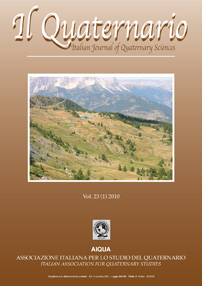Evoluzione geomorfologica quaternaria della conca intermontana di Carsoli (AQ)
Main Article Content
Abstract
: D’Orefice M. et al., Quaternary geomorphological evolution of Carsoli intermontane basin (L’Aquila, Italy). (IT ISSN 0394-
3356, 2010).
In the present work the results of a geological and geomorphological study are presented. The study has been carried out in the
Carsoli intermontane basin (AQ), a wide depression of tectonic origin, located between Abruzzo and Lazio regions, at the boundary of
two different palaeogeographic domains, separated by the “Olevano-Antrodoco” tectonic line.
The Carsoli basin is filled with a continental sedimentary succession of considerable thickness and extent, which has been classified
into several lithostratigraphic units, mainly on the basis of their lithological, morphological and geochronological characteristics.
The oldest continental sediments outcropping within the study area are of lacustrine origin (Bosco di Oricola silts, clays and sands).
These sediments, whose deposition has probably occurred in the Lower – Middle Pleistocene, are characterized by a maximum thickness of about 200 m. They are widespread in the north-western and central parts of the basin (Bosco di Oricola) and are locally present on the eastern edge of the basin.
The lacustrine deposits are cut across by an ancient sub-horizontal erosion surface, and at present, only some remnants remain.
The lacustrine sediments are covered, on the north-eastern edge of the basin, by coarse fluvial sediments suspended on the present
plain, originally deposited by the paleo-Turano River (Madonna delle Grazie gravels).
In the central-western and southern part of the study area, a significant sequence of local volcanic deposits, dated around 530 – 540
kyears BP, outcrops. The volcanic sequence abruptly begins from an articulated erosive surface shaped in lacustrine deposits and
Meso-Cenozoic carbonatic bedrock. Three main pyroclastic units are distinguished in the following members: 1) Oricola scalo opening–vent breccias, 2) Oricola Scalo grey tuffs, 3) S. Giovanni red tuffs. Only the last two units widely outcrops in the study area.
The Oricola Scalo opening-vent breccias are relative to the early opening phase of the conduit. They consist of a massive structure
connected to the depositional mechanisms of airfall and/or debris flow, separated by tuff layers related to base surge phenomena.
The Oricola Scalo grey tuffs unit mainly consists of grey ash-lapilli tuffs with surge cross-laminations, and grey lapilli tuffs with a massive structure of pyroclastic flow. The overlying S. Giovanni red tuffs are characterized, instead, by a thickness and distribution greater than that of underlying grey tuffs. The unit is mainly composed of red lapilli tuffs, with dune structures or a parallel lamination of surge and airfall.
After the lacustrine sedimentation and the volcanic episodes, the examined area underwent intense fluvial dynamics. This led to the
sedimentation, in the central-southern and eastern part of the basin, of a sequence of alluvial deposits belonging to different depositional events. The morpho-litho-stratigraphic analysis of these fluvial deposits, in addition with radiometric ages, allowed for their classification into four units (Prati gravels, sands and silts, Fioio Stream conglomerates, Immagine gravels, sands and silts, Turano River gravels, sands and silts) progressively embedded into each other and ranging in age between the late Middle Pleistocene and the Present.
Entrenched in the late Middle Pleistocene alluvial unit, in the southern sector of the basin (Fonte Bosco), a few hundred meters long
and 1.5 meters thick calcareous tufa layer, dated by U-series method at 46,000 ± 6,000 years BP outcrops.
With regard to the most recent depositional phases, great relevance has to be ascribed to the stratigraphic study carried out on the
Fosso Luisa fan (Camerata Nuova) and the radiometric dating of colluvial horizon, there present. This dating, providing a calibrated 14C
age of 3,550-3,400 years BP, has allowed for a temporal definition of some sedimentary and erosive events that marked the upper part
of the fan during the final part of Holocene.
Article Details
Section

This work is licensed under a Creative Commons Attribution-NonCommercial-NoDerivatives 4.0 International License.
The Author grants usage rights to others using an open license (Creative Commons or equivalent) allowing for immediate free access to the work and permitting any user to read, download, copy, distribute, print, search, or link to the full texts of articles, crawl them for indexing, pass them as data to software, or use them for any other lawful purpose.

